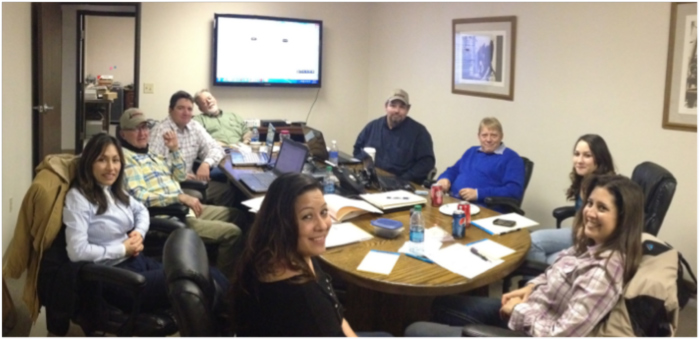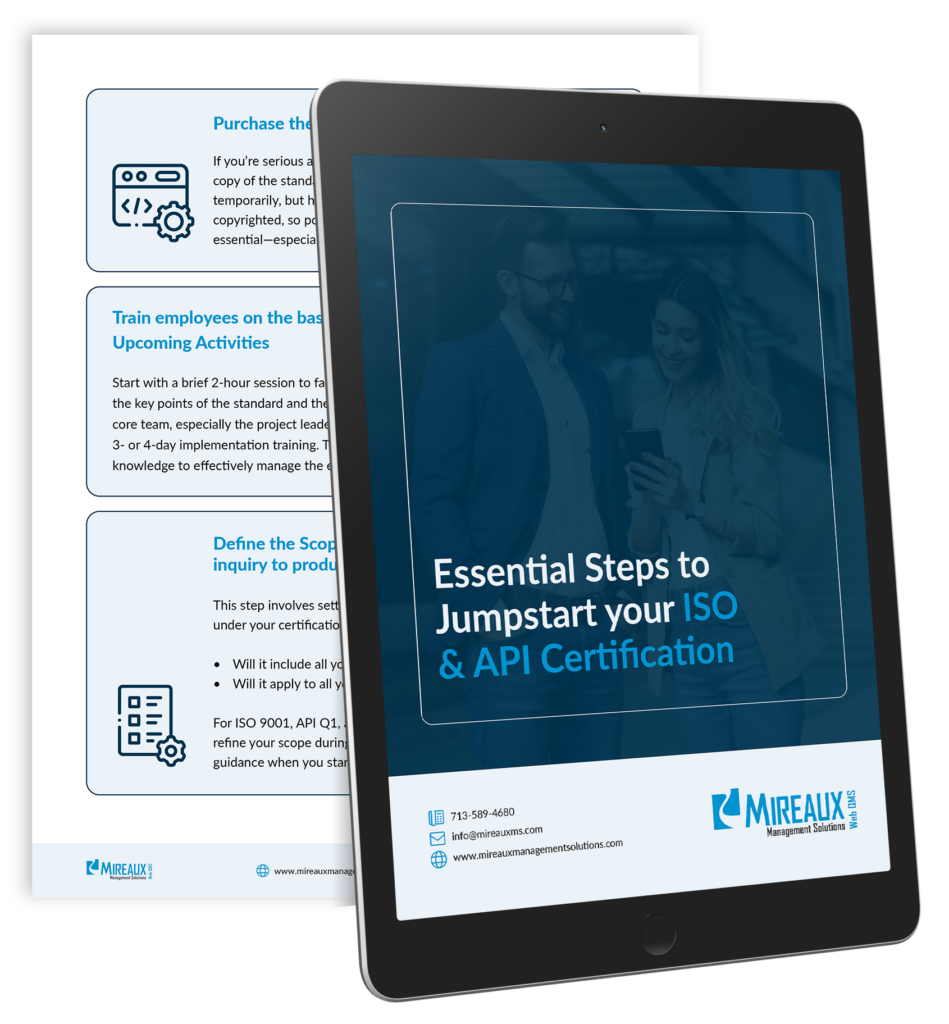On a beautiful January afternoon in Houston, I prepare to go to Farmington, New Mexico, a town of 45,000 that most people have never heard of. It’s 60 degrees and sunny in Houston. Next Monday is a holiday, so our pool is being heated to let the kids play over the weekend. For a minute, I wonder what I am doing. Why would I leave this gorgeous day and place. But API is calling.
We have been working for more than six months getting our client ready for API Spec Q2 certification and it is time to ensure they are prepared. I love what I do, so I say good bye to my family and the Houston (or is it “California“?) weather and off I go to Farmington.
The Trip
We get to the airport on time, my big coat in tow. We fly straight to Albuquerque in a little plane, the kind that has no first class. Not that I always fly first class, but I’m Silver Status now so I’m looking forward to any upgrades. Even before I left, my kid was fretting at the notion that I might travel in luxury. I told him first class is a consolation prize, not a reward, for those people who are not able to see their family much. That seemed to appease him.
Without much fanfare we arrive in Albuquerque. It’s only 5 pm, but already dark. We rent a car and prepare for 3 long hours or driving toward Farmington. During the drive, I ask my client why they chose Farmington. Why not a place near Albuquerque, close to a major airport? He tells me there is a lot of oil and gas activity in Farmington, with many drilling sites nearby. He tells me they almost dominate the region so it is actually an ideal, central location for them. There is not much scenery on the way there, not that we could see anyways, just the dark silhouettes of the mountains and beautiful rock formations. On occasion, we see the big casinos on Indian reservations, but besides that our eyes are mainly drawn to the starry night sky.
My contact asks me what exactly we are going to do, and how it differs from an audit. I tell him it’s an “Informal Assessment,” a term coined by our company and a critical part of the journey towards any certification. I explain that it can best be understood as a walk-through. He asks why we do this, since we have already gone over procedures many times, and everyone involved says they are well-practiced and following them closely. I tell him that we created this step in the certification process based on our vast experience. I explain that most companies approve procedures and say they are following them, but they usually are not executing as well as they can be. They don’t really snap to this fact until they are questioned about those procedures, or until the procedures are put “under the microscope.” He looks at me with an incredulous look on his face, and continues driving.
I assure him, that “although your company could very well be doing great”, this would not be a waste of his time or money.
We finally arrive in Farmington. There isn’t much to see or do in this small town. It’s also late and we know the next day will be a busy one, so we call it a night and make arrangements for the following morning.
API Spec Q2 “Informal Assessment” Day 1 – Nobody Said This Was Easy
We arrive at the yard location early in the morning, Starbucks coffee in hand. Yes, they do have a Starbucks in Farmington, so that’s a good start. In the yard, fresh air, air compression packages and equipment framed by the mountains in the background. Ah, I like it. It’s for this reason I wanted to be an Industrial Engineer – to work with this type of impressive equipment, and to help people improve the world around them.
We go into their office. A big trailer with a nice conference room, with a TV hung on the wall. Everyone from the Top Manager to the Office Manager is already there, waiting to get started. This will be our war room for the next 2 days.

We start the day looking at procedures on their main process map. I read the procedure line by line and ask simple questions, prompting them for evidence along the way. I don’t invent anything, I just read:
- The procedure says you need records of contract review and actions, may I see those for this proposal?
- The procedure says you keep records of design planning, design review and verification, may I see them for this design?
- The procedure says you send surveys after each project, may I see those?
- The procedure says purchase orders (POs) are approved according to the GOA, may I see who approved these two large-amount POs?
- The Approved Vendor List (AVL) says this vendor is approved for general supplies, but this PO shows you bought equipment from them, may I see the evaluation and approval?
- May I see reevaluation forms for suppliers on the AVL?
- The procedure says a Job Safety Analysis (JSA) will be conducted at loading, unloading, job execution, rig up and rig down, may I see a copy of those JSAs?
- May I see the certificates for the whip checks?
- A recent inventory count was conducted… may I select items from your current inventory to verify the count is accurate?
Time and again, we find that either the requested evidence is not there, is only partially there, the procedure was not understood or the procedure was just not followed. “It’s incredible,” my contact said. “This is exactly what you told me it would be. We have looked at these procedures countless times, individually and even together as a group, and we all agreed they were good.”
I tell him I see it as a “snapping” issue… people just don’t “snap“. They look at procedures, they see them, they read them, but they don’t snap to the reality of operating completely within the scope of the procedures. And often they only realize it when they are put under the bright light of the Informal Assessment.
 Lunch is brought in, then dinner. It’s already 5 pm and darkness is falling outside. The night is young in Farmington, NM, and there are more API clauses and procedures to go through. We continue.
Lunch is brought in, then dinner. It’s already 5 pm and darkness is falling outside. The night is young in Farmington, NM, and there are more API clauses and procedures to go through. We continue.
Things Get Heated
I know that that everyone around the table has worked hard to put the system together. In fact they have put in many working hours to improve their processes, but at this point, I can sense that they feel I’m after them. I came up with the “Informal Assessment” name because I felt that this is not an audit, nor is it consulting – it’s a combination of both. Throughout the question and answer, process, the team is fixing things using a hands-on approach.
Indeed, by now most procedures we printed have been red-lined to be more accurate and people understand that, yes, they are supposed to be following procedures “down to a tee,” or else the procedure or the process has to change. But that explanation is an objective one, and some of the team members are feeling the pinch that I’m poking at their system too much. Never mind that I’m on their side and fully vested in their system, and I’m discovering too many findings! I continue to assure them that this is just part of the preparation, and that a tough, outside auditor is going to come next to conduct the Internal Audit.
That seems to calm them down some, if at least by degrees.
We get to the issue of Short Service Employee (SSE). I read the procedure and ask for the records for the most recent employees who were sent on the job. Things don’t fully add up so I press on. People are tired. We even begin to argue. “I’m just asking what your procedure says you ought to be doing,” I clarify. That does not help, and I’m being told by these people that my “manufacturing mentality” cannot be applied to the procedures of a service company. I’ve heard this all before. I’ve been lectured about how service is not like manufacturing, or how piece manufacturing is not like mass production. Usually I let it slide. This time I don’t. I’m tired and frustrated, almost to the point where I want to give up. I’m just trying to help these people! I’m preparing them for the big bad auditors, our own auditor and the API auditor! But it does not matter. I’ve poked at the holes in their system too much today, and somebody wants to make sure I know it. It’s clear the procedure does not represent their ways, but it is hard to admit that. We can’t continue at this level of tension and disagreement.
Day 2 – Do you give up now or are you thirsty for more?
It’s another gorgeous day in Farmington. I’m in good spirits and my Starbucks is already waiting for me. In hindsight, the day before turned out to be very productive, despite our SSE mishap. Breakfast is waiting for us at the office and everyone is ready to get started. Indeed, we made many improvements the day before and some people ”snapped” to the true purpose of the procedures. The goal, you could say, was accomplished already.
We resume our work, looking for more evidence that API Spec Q2 is being implemented. That means more questioning and focused prodding:
 The procedure calls for new employees to go through these checks, may I see the evidence?
The procedure calls for new employees to go through these checks, may I see the evidence?- The procedure calls for new employees to have this orientation training, may I see the training records?
- The procedure calls for corrective action when a systemic problem occurred, may I see that for this issue that caused a termination, there was corrective action implemented?
- May I see the competency assessment for people who went on this job?
- May I see the full list of certifications for people who went on this job?
- The procedure indicates an MOC shall be conducted when key personnel leave, may I see one for this instance?
- The procedure indicates you will have a full risk assessment conducted, may I see that?
- May I see the established objectives?
- May I see the graphs corresponding to the objectives?
- The procedure indicates that all your assets are included in the Preventive Maintenance application of Web QMS, may I check if this new asset you received a month ago is in there?
- May I see the preventive maintenance records for all assets in the system?
People are in good spirits this morning and regardless of the difficulties they’ve experienced, they all see the value and benefits of what we’re doing. Yes, once again, evidence falls short, procedures are not being fully followed and the process needs some fixing. But excuses and arguments aside, we all know we are in this together. Even more importantly, if they are to achieve API certification, everyone had better “put on their big boy pants” and get on the bandwagon. I feel they have all come to terms with this fact and they are happy to be part of this session. Like I always told my kids when they were little, “after you fight, you kiss and make up and everything will be alright”.
We Will Make It
It has been two long days in Farmington, and it’s time to get back to Albuquerque. It’s another clear night and we drive the lonely highway, with only the stars and the silhouettes of the mountains in the distance watching over us.
Although there were plenty of tense moments, I can’t help but reflect that every part of the system – people, processes and the procedures – matured so much. We read together. We pointed things out together. We argued our points passionately. We accepted other points of view. We red-lined procedures. We proved things wrong and we proved things right. We uncovered things and we discovered things, and on the way, we fixed problems, debated new methods, implemented new, simpler processes on Web QMS and achieved a better outcome. We improved, we really improved.
In the end, API helped us get to another level.
When I returned to Houston, I heard a “polar vortex” cold front slammed the region, bringing frigid temperatures and keeping everyone at home bundled up indoors. Maybe I didn’t miss so much after all.The rules are changing and time is short. If you are a manufacturing company or a service provider, there is a good chance that you have heard about standards such as ISO 9001. In fact, you may already be certified.
Whether you are certified or not, read on for some of the expected trends in the world of standards and certification for 2018.
Advance Your Knowledge with API and ISO Training from Mireaux University
Whether you’re preparing for certification or ready to take your team’s expertise to the next level, Mireaux training gives you the tools to succeed. Through Mireaux University (Mireaux-U) — our dynamic online learning platform — you can access course materials anytime, watch exclusive bonus videos, take your online exam, and download your certificate instantly. Experience expert-led training and real-world insights designed to empower your success. And link Mireaux University to this page:



